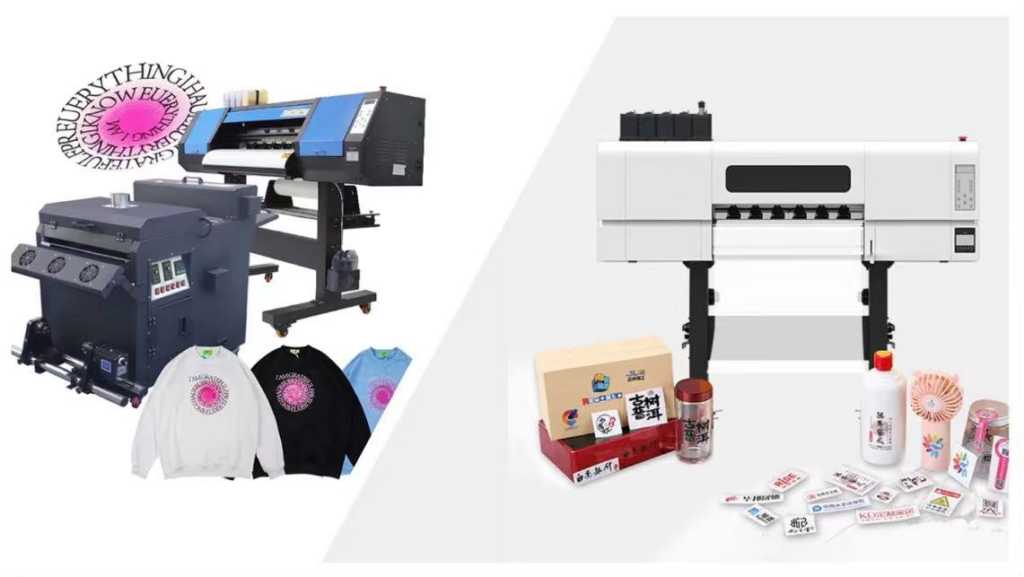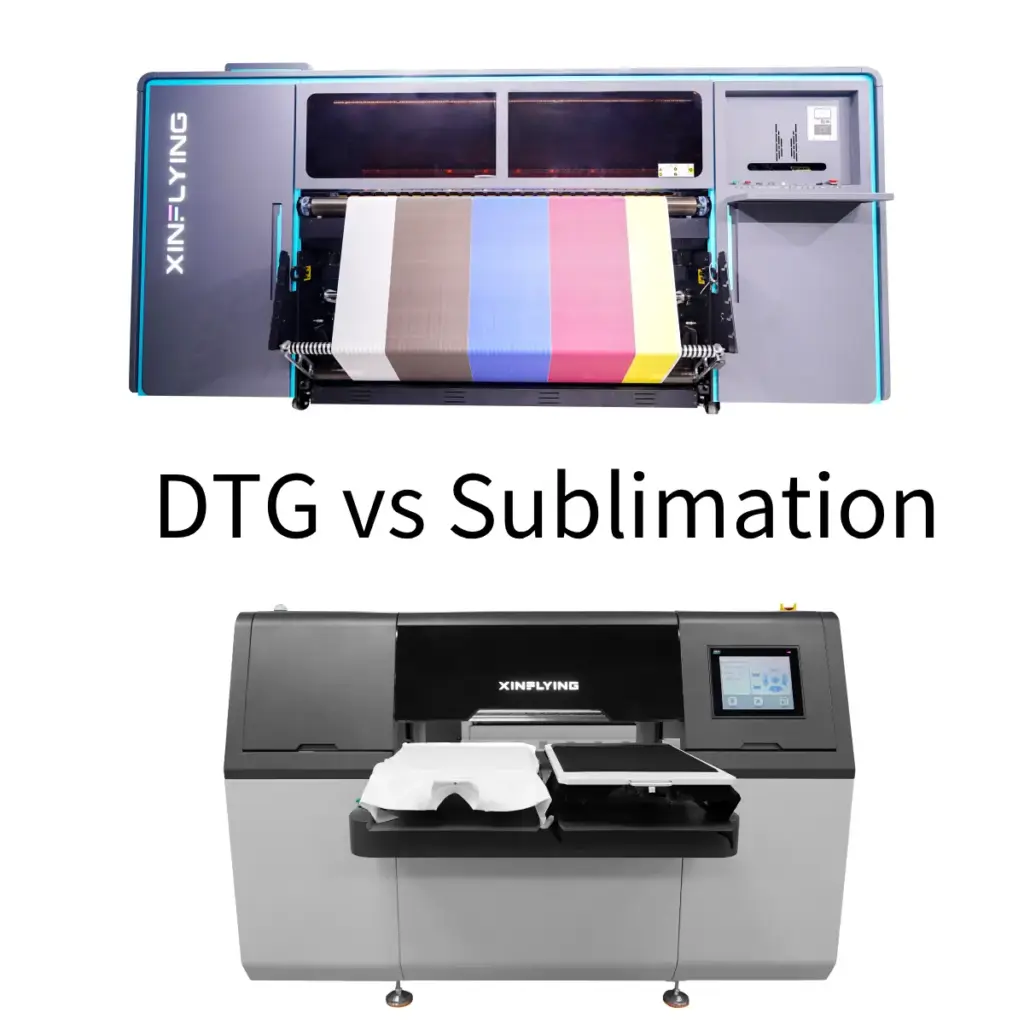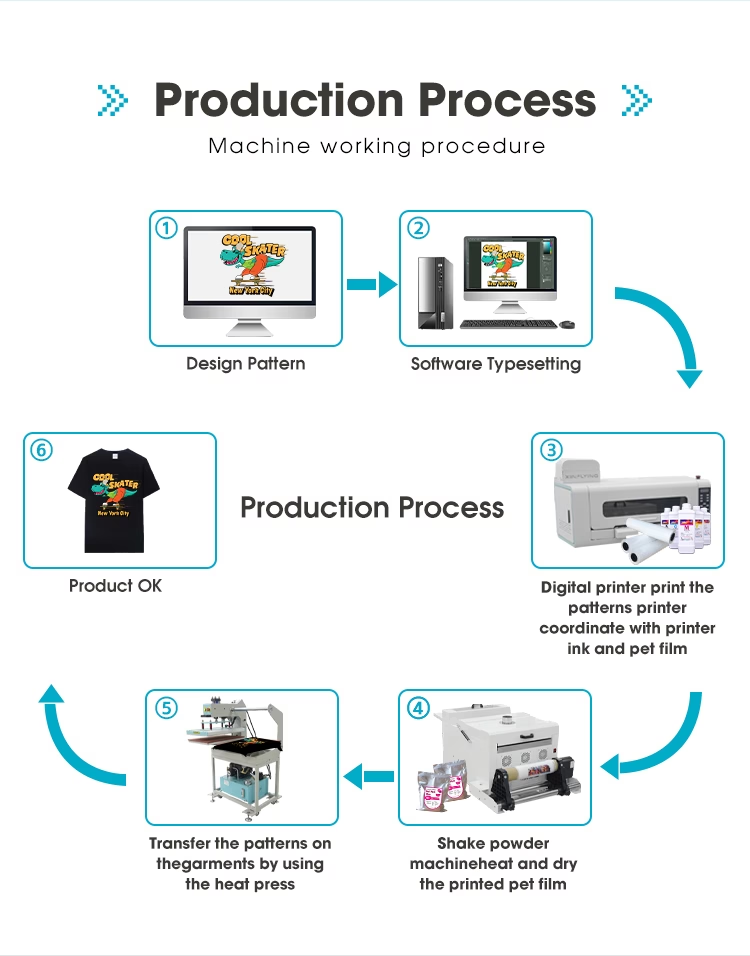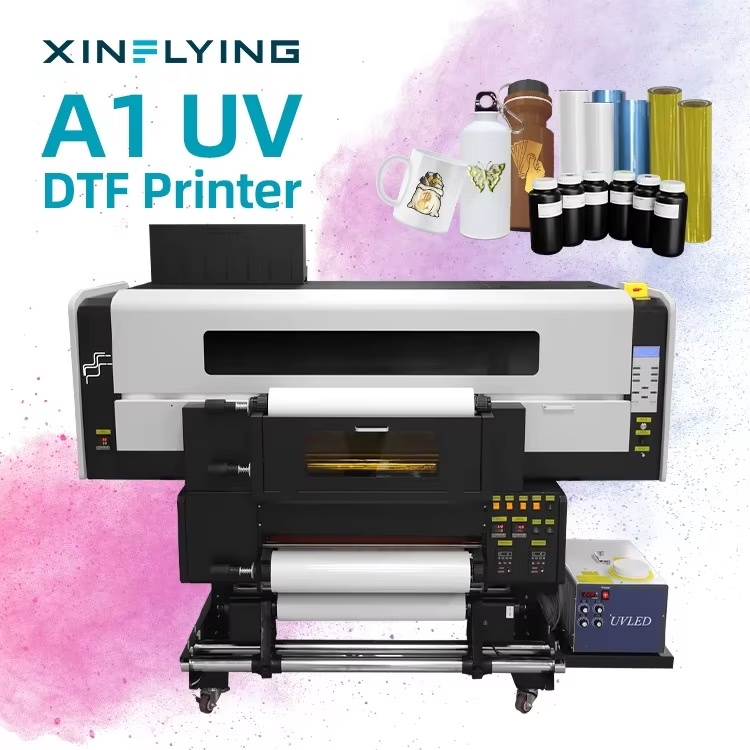मुद्रण प्रौद्योगिकी बहुत आगे बढ़ चुकी है, विभिन्न सतहों पर छवियों को जीवंत बनाने के लिए विभिन्न तरीकों की पेशकश. आज उद्योग में दो लोकप्रिय मुद्रण तकनीकें यूवी डीटीएफ प्रिंटिंग और डीटीएफ प्रिंटिंग हैं. जबकि दोनों विधियाँ प्रभावशाली परिणाम देती हैं, उनमें विशिष्ट विशेषताएं हैं जो उन्हें अलग करती हैं. इस आलेख में, हम प्रत्येक मुद्रण विधि के विवरण में गहराई से उतरेंगे, उनकी शक्तियों और सीमाओं की तुलना करें, और आपकी आवश्यकताओं के लिए सही मुद्रण विधि का चयन करने पर मार्गदर्शन प्रदान करें.
यूवी डीटीएफ प्रिंटिंग क्या है??
यूवी डीटीएफ प्रिंटिंग, अल्ट्रावॉयलेट डायरेक्ट टू फिल्म प्रिंटिंग का संक्षिप्त रूप, एक अत्याधुनिक तकनीक है जो विभिन्न सबस्ट्रेट्स पर उच्च गुणवत्ता वाली छवि स्थानांतरण की अनुमति देती है. पारंपरिक मुद्रण विधियों के विपरीत, यूवी डीटीएफ प्रिंटिंग पराबैंगनी विकिरण का उपयोग करता है (यूवी) असाधारण स्थायित्व और जीवंत रंगों के लिए यूवी प्रकाश से ठीक की गई स्याही.
यूवी डीटीएफ प्रिंटर का उपयोग कैसे करें?
कदम 1: RIP सॉफ़्टवेयर पर डिज़ाइन करें
पहले तो, कंप्यूटर पर RIP सॉफ़्टवेयर के साथ कलाकृति तैयार करें. फिर यूवी डीटीएफ ए फिल्म को यूवी डीटीएफ प्रिंटर के प्लेटफॉर्म पर रखें.
कदम 2: एक फिल्म पर प्रिंट करें
कार्ट्रिज को CMYK स्याही से पहले से भरें, सफ़ेद स्याही, और यूवी डीटीएफ ए फिल्म पर अपना डिज़ाइन मुद्रित करने के लिए वार्निश.
कदम 3: लैमिनेटेड बी फिल्म
मुद्रित ए फिल्म को बी फिल्म के साथ चिपकाने के लिए लैमिनेटिंग मशीन में डालें.
कदम 4: उत्पादों पर फिल्म लगाएं
पैटर्न की ए फिल्म को छीलें और इसे उस आइटम पर चिपका दें जिसे आप प्रिंट करना चाहते हैं. फिर धीरे-धीरे बी फिल्म को छीलें, और आपका उत्पाद समाप्त हो गया.
यूवी डीटीएफ प्रिंटिंग के फायदे और नुकसान

यूवी डीटीएफ मुद्रण के लाभ
- उच्च छवि गुणवत्ता और तीक्ष्णता
यूवी डीटीएफ प्रिंटिंग स्पष्ट विवरण और जीवंत रंगों के साथ असाधारण छवि गुणवत्ता प्रदान करती है. यूवी स्याही में व्यापक रंग सरगम होता है, सटीक रंग पुनरुत्पादन की अनुमति देता है.
- व्यापक रंग सरगम
यूवी डीटीएफ प्रिंटिंग विभिन्न सबस्ट्रेट्स पर रंगों की एक विस्तृत श्रृंखला को मुद्रित करने में सक्षम बनाती है, जिसके परिणामस्वरूप समृद्ध और जीवंत डिज़ाइन प्राप्त होते हैं.
- तेज़ उत्पादन समय
पारंपरिक मुद्रण विधियों की तुलना में, यूवी डीटीएफ प्रिंटिंग तेजी से उत्पादन समय प्रदान करती है. यूवी स्याही लगभग तुरंत सूख जाती है, विस्तारित सुखाने की अवधि की आवश्यकता को समाप्त करना.
- विभिन्न सबस्ट्रेट्स पर मुद्रित करने की क्षमता
यूवी डीटीएफ प्रिंटिंग विभिन्न सामग्रियों पर प्रिंट करने की सुविधा प्रदान करती है, कपड़े सहित, प्लास्टिक, काँच, और अधिक. यह बहुमुखी प्रतिभा इसे उन व्यवसायों के लिए एक आदर्श विकल्प बनाती है जो अपने उत्पाद की पेशकश में विविधता लाना चाहते हैं.
यूवी डीटीएफ प्रिंटिंग की सीमाएं
- यूवी स्याही और उपकरण की लागत
यूवी डीटीएफ प्रिंटिंग के लिए विशेष यूवी स्याही और उपकरण की आवश्यकता होती है, जो पारंपरिक मुद्रण सामग्री की तुलना में अधिक महंगा हो सकता है. इसके अतिरिक्त, यूवी स्याही की शेल्फ लाइफ कम हो सकती है, बार-बार प्रतिस्थापन की आवश्यकता होती है.
- कुछ सामग्रियों के साथ सीमित लचीलापन
जबकि यूवी डीटीएफ प्रिंटिंग को विभिन्न सबस्ट्रेट्स पर लागू किया जा सकता है, कुछ सामग्रियाँ अपनी बनावट या सतह संरचना के कारण उपयुक्त नहीं हो सकती हैं. बड़े पैमाने पर उत्पादन करने से पहले विभिन्न सामग्रियों पर प्रिंट का परीक्षण करना महत्वपूर्ण है.
- रखरखाव एवं रख-रखाव संबंधी आवश्यकताएँ
यूवी डीटीएफ प्रिंटिंग उपकरण को निरंतर प्रदर्शन सुनिश्चित करने के लिए नियमित रखरखाव और रख-रखाव की आवश्यकता होती है. इसमें प्रिंटर हेड की सफाई और यूवी इलाज के लिए इष्टतम स्थिति सुनिश्चित करना शामिल है.
डीटीएफ प्रिंटिंग क्या है??
डीटीएफ मुद्रण, या फिल्म मुद्रण के लिए सीधे, एक ऐसी तकनीक है जिसमें विशेष स्याही का उपयोग करके फिल्म पर डिज़ाइन प्रिंट करना शामिल है, जिन्हें बाद में वांछित सब्सट्रेट पर स्थानांतरित कर दिया जाता है.
डीटीएफ प्रिंटर का उपयोग कैसे करें?
कदम 1: RIP सॉफ़्टवेयर पर डिज़ाइन करें
यूवी डीटीएफ प्रिंटिंग के समान, ग्राफ़िक डिज़ाइन सॉफ़्टवेयर का उपयोग करके कलाकृति डिज़ाइन करें, यह सुनिश्चित करना कि वांछित डिज़ाइन और छवि गुणवत्ता प्राप्त की जाए.
कदम 2: पीईटी फिल्म पर प्रिंट करें
इसमें पीईटी फिल्म डालें डीटीएफ प्रिंटर ट्रे और मुद्रण शुरू करें. फिर उस पर डिज़ाइन पैटर्न ट्रांसफर किया जाएगा.
कदम 3: पाउडर के साथ बांड स्याही
पाउडर शेकिंग मशीन के साथ, the डीटीएफ चिपकने वाला पाउडर पीईटी फिल्म पर समान रूप से फैल सकता है और ग्राफिक्स को सुखा सकता है.
कदम 4: कपड़ा पर स्थानांतरण पैटर्न
डीटीएफ पीईटी फिल्म को सब्सट्रेट के शीर्ष पर रखें और हीट प्रेस मशीन का उपयोग करके डिजाइन को स्थानांतरित करें.
डीटीएफ प्रिंटिंग के फायदे और नुकसान

डीटीएफ प्रिंटिंग के लाभ
- लागत प्रभावी मुद्रण विधि
डीटीएफ प्रिंटिंग को लागत प्रभावी माना जाता है, मुख्य रूप से यूवी डीटीएफ प्रिंटिंग की तुलना में इसके कम उपकरण और स्याही लागत के कारण. यह छोटे व्यवसायों और मुद्रण उद्योग में उद्यम करने के इच्छुक व्यक्तियों के लिए इसे सुलभ बनाता है.
- संगत सबस्ट्रेट्स के संदर्भ में बहुमुखी प्रतिभा
यूवी डीटीएफ प्रिंटिंग की तरह, डीटीएफ प्रिंटिंग विभिन्न सबस्ट्रेट्स पर प्रिंटिंग की अनुमति देती है, कपड़े सहित, चीनी मिट्टी की चीज़ें, प्लास्टिक, और अधिक. यह बहुमुखी प्रतिभा उन उत्पादों की श्रृंखला का विस्तार करती है जिन्हें डीटीएफ प्रिंटिंग का उपयोग करके उत्पादित किया जा सकता है.
- जीवंत रंग और बारीक विवरण प्राप्त करने की क्षमता
डीटीएफ प्रिंटिंग जीवंत और ज्वलंत रंग प्राप्त कर सकती है, साथ ही बारीक विवरण भी, इसे जटिल डिज़ाइन और जटिल कलाकृति के लिए उपयुक्त बनाना.
- प्रयोग करने और साफ करने में आसान है
डीटीएफ प्रिंटर उपयोगकर्ता के अनुकूल हैं, न्यूनतम सेटअप और रखरखाव की आवश्यकता है. इसके अतिरिक्त, सफाई प्रक्रिया अपेक्षाकृत सरल है, सुचारू संचालन और कम डाउनटाइम की अनुमति.
डीटीएफ प्रिंटिंग की सीमाएँ
- यूवी डीटीएफ की तुलना में सीमित रंग सरगम
जबकि डीटीएफ प्रिंटिंग जीवंत रंग प्राप्त कर सकती है, इसका रंग सरगम यूवी डीटीएफ की तुलना में संकीर्ण हो सकता है, पुनरुत्पादित किए जा सकने वाले रंगों और टोन की सीमा को सीमित करना.
- अधिक उत्पादन समय
डीटीएफ प्रिंटिंग के लिए डिज़ाइन को सब्सट्रेट पर स्थानांतरित करने के लिए अतिरिक्त चरणों की आवश्यकता हो सकती है, जिसके परिणामस्वरूप यूवी डीटीएफ प्रिंटिंग की तुलना में उत्पादन में अधिक समय लग सकता है.
- कुछ कपड़ों के लिए अतिरिक्त कदमों की आवश्यकता हो सकती है
कुछ कपड़ों को छपाई से पहले पूर्व-उपचार प्रक्रियाओं की आवश्यकता हो सकती है डीटीएफ स्याही. इससे समग्र मुद्रण प्रक्रिया में जटिलता और समय लग सकता है.
यूवी डीटीएफ वीएस डीटीएफ: एक तुलना

ए. प्रिंट गुणवत्ता तुलना
संकल्प और तीक्ष्णता
यूवी डीटीएफ और डीटीएफ प्रिंटिंग दोनों ही तेज विवरण के साथ उच्च-रिज़ॉल्यूशन प्रिंट प्राप्त कर सकते हैं. तथापि, यूवी इलाज प्रक्रिया के कारण यूवी डीटीएफ प्रिंटिंग थोड़े बेहतर परिणाम दे सकती है, जो स्याही के स्थायित्व को बढ़ाता है.
रंग सटीकता और जीवंतता
यूवी डीटीएफ प्रिंटिंग आम तौर पर एक व्यापक रंग सरगम प्रदान करती है, अधिक सटीक रंग पुनरुत्पादन और जीवंत डिज़ाइन की अनुमति देता है. डीटीएफ मुद्रण, जबकि जीवंत रंगों में सक्षम, कुछ शेड्स और टोन प्राप्त करने में सीमाएँ हो सकती हैं.
बी. सबस्ट्रेट्स के प्रकार
कपड़ा विकल्प
यूवी डीटीएफ और डीटीएफ प्रिंटिंग दोनों का उपयोग विभिन्न प्रकार के कपड़ों पर प्रिंट करने के लिए किया जा सकता है, कपास सहित, पॉलिएस्टर, और मिश्रण करता है. तथापि, इष्टतम स्याही आसंजन सुनिश्चित करने के लिए डीटीएफ प्रिंटिंग को कुछ कपड़ों के लिए अतिरिक्त चरणों या पूर्व-उपचार की आवश्यकता हो सकती है.
कठोर सतहों पर मुद्रण
जब कांच जैसी कठोर सतहों पर मुद्रण की बात आती है, प्लास्टिक, या चीनी मिट्टी की चीज़ें, यूवी डीटीएफ प्रिंटिंग पसंदीदा विकल्प है. यूवी इलाज प्रक्रिया इन सतहों पर उत्कृष्ट स्याही पालन और स्थायित्व सुनिश्चित करती है.
सी. उत्पादन की गति और दक्षता
यूवी डीटीएफ प्रिंटिंग डीटीएफ प्रिंटिंग की तुलना में तेजी से उत्पादन समय प्रदान करती है. यूवी डीटीएफ स्याही के तुरंत सूखने से सुखाने की विस्तारित अवधि की आवश्यकता समाप्त हो जाती है, अधिक कुशल वर्कफ़्लो की अनुमति देना.
डी. लागत तुलना
विशिष्ट यूवी स्याही और आवश्यक उपकरणों के कारण यूवी डीटीएफ प्रिंटिंग में आम तौर पर अग्रिम लागत अधिक होती है. डीटीएफ मुद्रण, वहीं दूसरी ओर, अपनी शुरुआत करने वालों के लिए अधिक लागत प्रभावी प्रवेश बिंदु प्रदान करता है
मुद्रण उद्यम.
ई. रखरखाव और रख-रखाव आवश्यकताएँ
यूवी डीटीएफ और डीटीएफ प्रिंटिंग उपकरण दोनों को नियमित रखरखाव और रख-रखाव की आवश्यकता होती है. तथापि, यूवी स्याही की प्रकृति के कारण यूवी डीटीएफ प्रिंटर को अधिक बार सफाई और स्याही प्रतिस्थापन की आवश्यकता हो सकती है.
डीटीएफ बनाम यूवी डीटीएफ, कौन सा बहतर है?
| प्रकार | डीटीएफ प्रिंटिंग | यूवी डीटीएफ प्रिंटिंग |
| तकनीकी | एक फिल्म पर प्रिंट होता है जिसे फिर सामग्री पर गर्म करके दबाया जाता है. | स्याही को तुरंत ठीक करने के लिए डीटीएफ तकनीक को यूवी प्रकाश के साथ जोड़ता है. |
| आईएनके | CMYK+ सफेद स्याही का उपयोग करता है, एक स्पष्ट पीईटी फिल्म पर मुद्रित. | यूवी स्याही का उपयोग करता है, एक स्पष्ट पीईटी फिल्म पर मुद्रित. |
| आवेदन | कपास, पॉलिएस्टर, कपास-पॉली मिश्रण, चमड़ा, नायलॉन, और अधिक. | कपास, पॉलिएस्टर, कपास-पॉली मिश्रण, चमड़ा, नायलॉन, प्लास्टिक, लकड़ी, धातु, और यहां तक कि कांच भी, और अधिक. |
| विवरण | बहुत उच्च छवि गुणवत्ता और विवरण. | उच्च छवि गुणवत्ता और विवरण, हालाँकि यूवी प्रक्रिया इसे थोड़ा प्रभावित कर सकती है. |
| सहनशीलता | अत्यधिक टिकाऊ, लेकिन यह UV DTF जितने लंबे समय तक नहीं चल सकता. | अत्यधिक टिकाऊ, यूवी प्रक्रिया प्रिंट की आयु बढ़ाती है. |
डीटीएफ बनाम यूवी डीटीएफ तुलना तालिका
यूवी डीटीएफ प्रिंटिंग कब चुनें
यूवी डीटीएफ प्रिंटिंग उन व्यवसायों या व्यक्तियों के लिए उपयुक्त विकल्प है जो जीवंत रंगों और तेज विवरण के साथ उच्च गुणवत्ता वाले प्रिंट की तलाश में हैं. यह उन लोगों के लिए आदर्श है जो तेज़ उत्पादन समय को प्राथमिकता देते हैं, कठोर सतहों पर मुद्रण की आवश्यकता होती है, और प्रारंभिक उच्च लागतों को समायोजित कर सकता है.
डीटीएफ प्रिंटिंग कब चुनें?
प्रिंटिंग उद्योग में शुरुआत करने वालों के लिए डीटीएफ प्रिंटिंग एक लागत प्रभावी विकल्प है. यह संगत सब्सट्रेट्स के मामले में बहुमुखी प्रतिभा प्रदान करता है और इसका उपयोग और रखरखाव अपेक्षाकृत आसान है. डीटीएफ प्रिंटिंग की अनुशंसा उन लोगों के लिए की जाती है जो लागत दक्षता को प्राथमिकता देते हैं, मुद्रण सामग्री में बहुमुखी प्रतिभा, और संचालन में सरलता.
सही मुद्रण विधि का चयन करना

वांछित प्रिंट गुणवत्ता
छवि तीक्ष्णता के स्तर पर विचार करें, रंग सटीकता, और आपके प्रिंट के लिए जीवंतता आवश्यक है. इन क्षेत्रों में यूवी डीटीएफ प्रिंटिंग उत्कृष्ट है, जबकि डीटीएफ प्रिंटिंग सम्मानजनक प्रिंट गुणवत्ता के साथ अधिक लागत प्रभावी विकल्प प्रदान करती है.
मुद्रित की जाने वाली सामग्रियों का प्रकार
उन सबस्ट्रेट्स की विविधता को ध्यान में रखें जिन पर आप प्रिंट करने की योजना बना रहे हैं. यदि आप कठोर सतहों या सामग्रियों पर मुद्रण की आवश्यकता का अनुमान लगाते हैं जिन्हें पूर्व-उपचार की आवश्यकता हो सकती है, यूवी डीटीएफ प्रिंटिंग बेहतर विकल्प है.
उत्पादन मात्रा और समय सीमा
यदि आपके पास सख्त उत्पादन समय सीमा या उच्च मात्रा में मुद्रण की आवश्यकताएं हैं, यूवी डीटीएफ प्रिंटिंग का तेज़ उत्पादन समय अधिक उपयुक्त हो सकता है. तथापि, यदि उत्पादन मात्रा प्राथमिक चिंता नहीं है, डीटीएफ प्रिंटिंग एक सक्षम विकल्प प्रदान करती है.
उपलब्ध बजट
उपकरण के लिए अपने उपलब्ध बजट पर विचार करें, स्याही, और रखरखाव. यूवी डीटीएफ प्रिंटिंग के लिए आम तौर पर अधिक अग्रिम निवेश की आवश्यकता होती है, जबकि डीटीएफ प्रिंटिंग अधिक लागत प्रभावी प्रवेश बिंदु प्रस्तुत करती है. भी, एक चुनना महत्वपूर्ण है विश्वसनीय फैब्रिक प्रिंटर निर्माता.
निष्कर्ष
निष्कर्ष के तौर पर, यूवी डीटीएफ प्रिंटिंग और डीटीएफ प्रिंटिंग दो अलग-अलग विधियां हैं जो असाधारण छवि गुणवत्ता और बहुमुखी प्रतिभा प्रदान करती हैं.
जीवंत रंगों के मामले में यूवी डीटीएफ प्रिंटिंग उत्कृष्ट है, तेज विवरण, और विभिन्न सबस्ट्रेट्स पर मुद्रित करने की क्षमता, इसे उच्च बजट आवंटन और विशिष्ट मुद्रण आवश्यकताओं वाले व्यवसायों के लिए आदर्श बनाना. डीटीएफ मुद्रण, वहीं दूसरी ओर, छोटे व्यवसायों और बहुमुखी प्रतिभा चाहने वाले व्यक्तियों के लिए एक लागत प्रभावी प्रवेश बिंदु प्रदान करता है, सादगी, और उपयोग में आसानी.
अंत में, यूवी डीटीएफ प्रिंटिंग और डीटीएफ प्रिंटिंग के बीच चयन प्रिंट आवश्यकताओं जैसे कारकों पर निर्भर करता है, सब्सट्रेट विविधता, उत्पादन मात्रा, और उपलब्ध बजट. इन कारकों पर विचार करके और प्रत्येक विधि की शक्तियों और सीमाओं को समझकर, आप सोच-समझकर निर्णय ले सकते हैं और उत्कृष्ट मुद्रण परिणाम प्राप्त कर सकते हैं.






